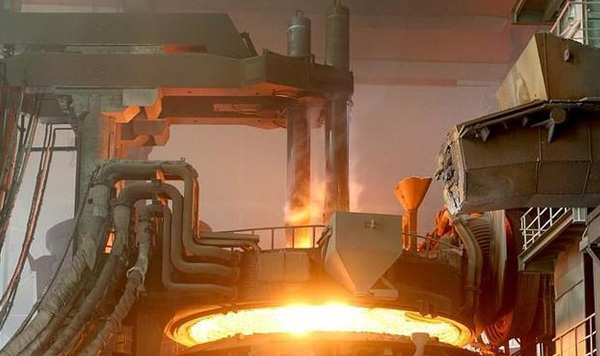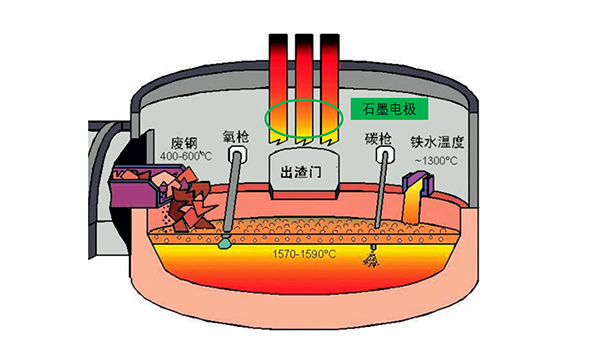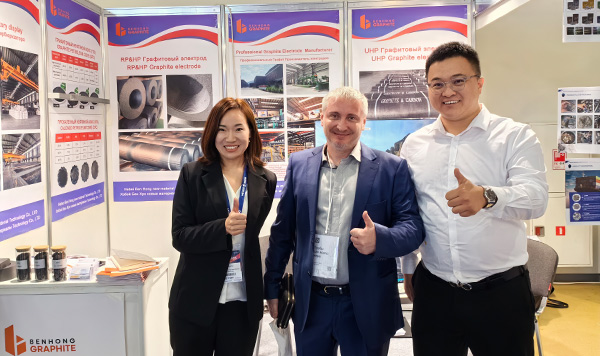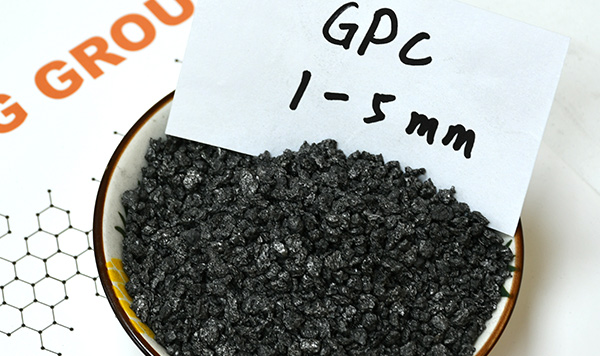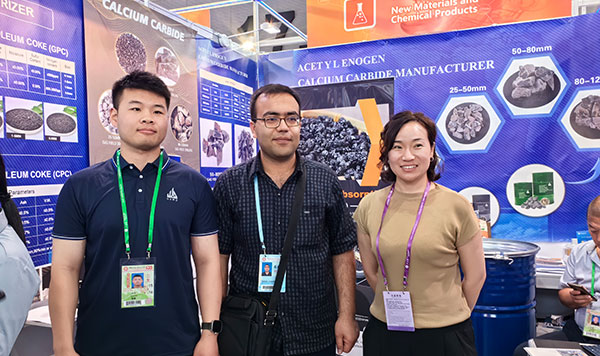Part of the reason for the breakage of graphite electrodes is operation and control, but the quality of the electrode itself is also a determining factor in electrode breakage.
Electrode intrinsic quality reasons
(1) Reasons for broken joints Joints play a key role in connecting electrodes during steelmaking. The quality of the joints is directly related to the use of electrodes in electric furnace steelmaking. The connection area formed by graphite electrodes and joints is a site subject to large and complex electrical, thermal, and mechanical loads, and is also a site of common fractures. According to relevant data, in electric furnace steelmaking, more than 80% of electrode usage accidents are caused by joint breakage or loosening. As far as the quality of the joint itself is concerned, the main reasons for breakage are as follows: the joint volume density is low, so the strength is generally low, and it is easy to break during use; the resistivity is high, and the temperature of the joint part rises quickly when power is turned on, which will cause The resulting thermal stress in the joint at the electrode connection increases the probability of breakage; the flexural strength of the joint is insufficient; internally cracked joints are mixed into the finished joint, causing major hidden dangers; the joint and electrode processing accuracy indicators are not reasonably matched, and breakage is prone to occur Phenomenon.
(2) Causes of electrode breakage Usually the probability of electrode breakage is low. The main reasons for electrode breakage are as follows: quality defects in the electrode screw hole; insufficient volume density and strength of the electrode; electrode and joint indicators, processing accuracy Mismatch; deep cracks at the end of the electrode are caused by poor thermal shock resistance of the electrode; in addition, electrodes with internal transverse cracks are mixed into the finished product and are not detected, posing a great risk of breakage.
Preventive measures and operational suggestions
1 Preventive measures against breakage during smelting operations
(1) Reasonable distribution structure: The distribution of various scrap steel materials in the basket and the conditions of adding them into the furnace must be reasonably configured to prevent light and thin steel materials from forming a ball on the top of the furnace and making it difficult to go down, and to avoid large pieces of scrap steel from collapsing and causing power outages. pole.
(2) During smelting, especially when it is close to melting, the distribution of unmelted furnace materials should be carefully observed. If a bridging structure has been formed, oxygen blowing or physical swinging or shaking should be used first to allow the furnace material to collapse when the power is out and the electrode has been raised to a high level to prevent the collapse of the material from breaking the electrode.
(3) The electrode should be of strength suitable for the process requirements. Use nuts of appropriate strength to connect electrodes, clean them, and use special clamping tools. Before replacing the electrode and lifting, the lifting ring must be tightened to ensure that the lifting ring is in close contact with the electrode. To ensure the cleanliness of the interface, it is required to keep the end cap of the new electrode until the lifting ring is installed.
(4) The electrode holder should avoid being caught in the white line between the electrode connections. The electrode connection must not be above the electrode holder. The electrode holder cannot be clamped on an open socket or a socket with a lifting ring.
2. Precautions during the control process
(1) After high-voltage power is transmitted, it is necessary to observe whether the three-phase no-load voltage of the secondary short network is balanced (determined by the insulation resistance of the three-phase short network to ground, the unbalanced voltage should be within 10%).
(2) Before the electrode automatically lowers, confirm that there are no non-conductive objects in the scrap steel layer directly under the electrode.
(3) After the first phase electrode drops and contacts the scrap steel, observe whether the secondary voltage of the phase electrode drops immediately.
(4) When an arc occurs in a certain phase electrode, can the secondary current display of that phase electrode be seen (the ammeter pointer has a large swing).
(5) Regularly detect whether the braking force of the electrode hydraulic drive mechanism and the system delay coefficient have changed.
In terms of internal quality of the electrode, many scholars have conducted more detailed research on the impact of the key technical indicators of the electrode (joint) on the electrode breakage during the smelting process. It is worth mentioning that the China Carbon Industry Association has conducted product quality spot checks on member companies, and compared and analyzed the test indicators of product spot checks with national standards and corporate standards of well-known foreign companies. Judging from the testing indicators, most of the indicators of all tested products comply with the YB-2000 standard, and some indicators have reached or are close to the standards of foreign companies. However, the actual smelting effect of domestic ultra-high-power graphite electrodes is significantly different from that of foreign products of the same specifications. Therefore, it is one-sided to judge the quality of electrodes (joints) based only on the physical and chemical indicators of the electrodes (joints). This should be fully considered. We will establish a set of scientific and reasonable electrode production and technical usage plans based on the compatibility of the factory’s products with the smelting processes, furnace structures, smelting steel types and other comprehensive factors of different customers.
in conclusion
(1) Factors such as material collapse, resonance, irregular clamping operations, abnormal conditions of the electrode regulator, the hydraulic drive mechanism of the electrode regulator, and improper control measures for the intrinsic quality of the electrode can cause the electric furnace electrode to break.
(2) By taking corresponding technical and management measures for factors such as cloth structure, electrode clamping, secondary short network no-load voltage, non-conductive objects, secondary current, braking force of the electrode hydraulic drive mechanism and system delay coefficient, The phenomenon of electrode breakage can be significantly improved.
(3) There is a certain degree of one-sidedness in judging the quality of electrodes (joints) based on their physical and chemical indicators. Full consideration should be given to the matching of our products with different customers’ smelting processes, furnace structures, smelting steel types and other comprehensive factors. nature, and establish a set of scientific and reasonable electrode production and technical use plans.


